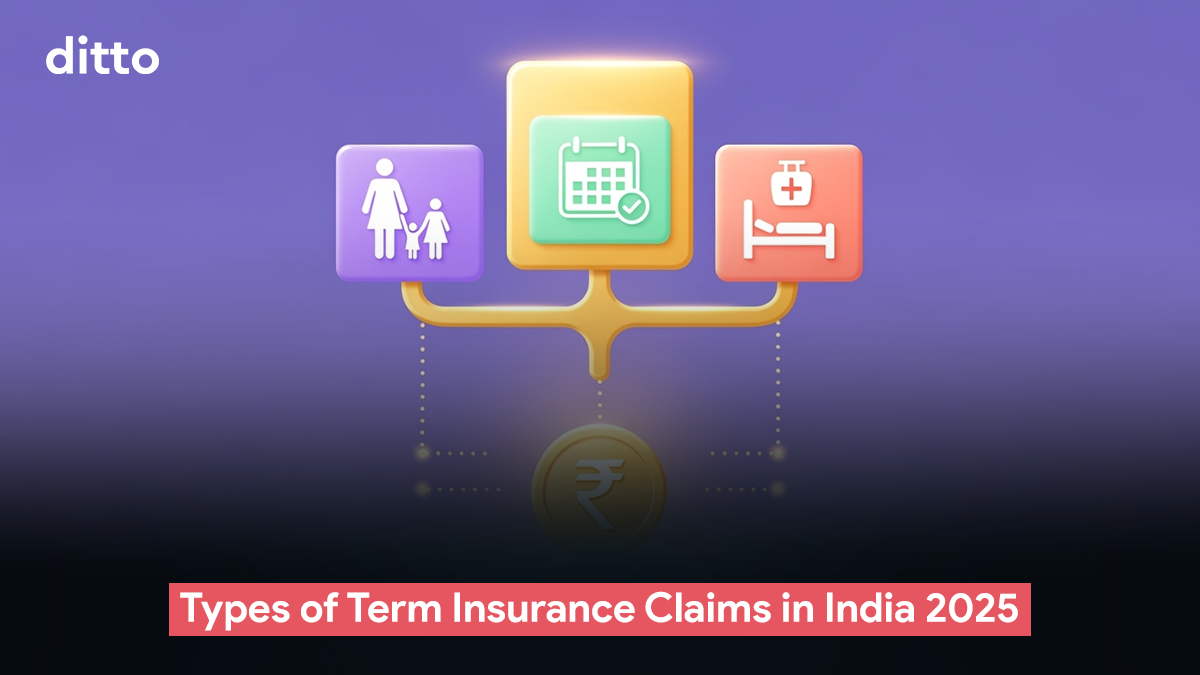| What is a Term Insurance Claim? A term insurance claim is a formal request made by the nominee or beneficiary to the insurance company for the payout of the death benefit when the policyholder dies during the policy term. Sometimes, it can also be a maturity, rider benefit, surrender/special exit claim. Usually, the claim process involves submitting required documents, such as the death certificate, KYC records, and policy documents, after which the insurer verifies the claim and disburses the sum assured to the nominee. |
Term insurance can provide financial support to a policyholder's family, but accessing these benefits isn't always straightforward. At Ditto, we've seen how confusing the process can be for those unfamiliar with the various types of term insurance claims.
Being informed can help ease the burden, prevent costly mistakes, and ensure your family gets the support they’re entitled to, without unnecessary delays. That’s why we’ve created this guide on term insurance claims, their types, payment methods, and other key details.
Bought your term insurance policy via Ditto? Reach out to our expert claims team and they will guide you every step of the way. Get claims assistance now.
What are the Types of Term Insurance Claims?
Here is a list of the types of term insurance claims a nominee or beneficiary can file with a life insurance company.
1) Death Benefit Claim
This is the most common type of claim for a term plan, which is a "pure protection" policy with no investment component.
- What it is: The beneficiary of the policy receives the sum assured (the amount of life cover) after the policyholder's death.
- How it is paid: Depending on the policy terms selected at purchase, the payout can be a lump sum amount, a series of regular installments, or a combination of both.
Check out this sample death claim form for your reference.
Ditto’s Take: To ensure quicker processing, the insurer should be informed of the death as soon as possible, even if it takes some time to gather the required documents for making a claim.
| Did You Know? Newer term insurance plans now come with an Instant Payout on Claim Intimation feature. As soon as the insurer is informed of the policyholder's demise and basic documents, such as the death certificate, are submitted, the insurer releases an immediate advance payout (₹50,000–₹5,00,000). This amount helps families cover urgent needs, such as hospital bills, funeral costs, or daily expenses, without waiting for the full claim settlement. Later, the insurer completes its full verification. If the claim is rejected, the advance payout must be returned. |
2) Maturity Benefit Claim
Generally, pure term insurance policies do not include a maturity benefit if the policyholder outlives the policy term. However, a maturity benefit claim can be filed under a specific type of plan.
- What it is: If the policyholder survives the entire term of a Term Insurance with Return of Premium (TROP) policy, the insurer refunds all premiums paid, excluding GST and any rider premiums.
- How it is claimed: To receive the refund, the policyholder must file a maturity claim with the insurer at the end of the term, provided that all past premiums have been paid.
Check out this sample maturity form for your reference.
Ditto’s Take: While TROP plans offer the assurance of receiving your premiums back if you survive the policy term, they are significantly more expensive. Generally, their prices are around 1.5 to 2 times the cost of a pure term insurance plan.
Since the refunded premiums do not generate any interest or profit, it is more financially sensible to choose a pure term plan and invest the extra amount in instruments that provide higher returns over the long term.
3) Rider Benefit Claim
Riders are optional add-ons purchased at a nominal extra cost to provide enhanced coverage for specific circumstances.
- What it is: If a policy includes riders, a claim can be made for additional benefits when the qualifying event occurs. Common riders include:
- Critical illness rider: Provides a lump-sum payment upon diagnosis of a covered critical illness, such as cancer or heart disease (See the sample form here).
- Accidental death benefit rider: Pays an additional sum if the policyholder's death is a result of an accident.
- Waiver of premium rider: Waives all future premiums if the policyholder becomes permanently disabled or critically ill, allowing the policy to remain active.
Ditto’s Advice: Do not assume that a rider covers everything and carefully read the policy wording. If you have any doubts, book a call with our advisors for guidance.
What Role Does Surrender or Special Exit Claim Play in Term Insurance?
The policyholder initiates a surrender or special exit claim during their lifetime. It means they are voluntarily exiting the plan before maturity, and depending on the product design, they may get some surrender value or exit benefit in return.
This is unlike a death claim, which is paid to nominees when the life assured passes away during the policy term. Let's examine two plan types to gain a deeper understanding of this claim process.
1) Zero-Cost Term Plans
These are newer-generation term plans that allow the policyholder to “walk away” at a certain point. The most common examples are HDFC Life C2P Supreme and Axis Max Life Smart Term Plan Plus.
- Special/Smart Exit Option: Usually available after a fixed number of years (e.g., after age 55/60 or after completing 25–35 years of the policy).
- Benefit: 100% or part of the premiums paid may be refunded (after deducting rider cost and GST).
- Purpose: If the policyholder feels they no longer need life cover, they can recover premiums instead of just discontinuing the plan without benefit.
2) Limited Pay Term Plans
These plans require you to pay premiums for a shorter duration (such as 10, 15, or 20 years), but coverage continues for a longer term.
- Surrender Value: If the policyholder surrenders the plan before the term expires, a surrender value (based on IRDAI rules and the insurer's formula) may be payable. You can check the availability and amount payable in the term plan benefit illustration document.
- Key Condition: Usually arises only if the premium payment term has been fully completed. Before that, exiting may lead to no value or a minor payout.
Ditto’s Take on Different Types of Term Insurance Claims
As long as you submit the required documents and maintain transparency, your claim will be settled. However, because term insurance involves a high payout, insurers often take extra time to investigate the claim and verify details against the policy’s underwriting records.
The best approach is to fully cooperate with the insurer during this process. Insurers are equally motivated to settle genuine claims quickly, as a higher Claim Settlement Ratio (CSR) boosts their credibility, improves their marketing efforts, and reinforces the trust customers place in them.
Why Choose Ditto for Term Insurance?
At Ditto, we’ve assisted over 8,00,000 customers with choosing the right term insurance policy. Here’s why customers like Ajay love us:

✅No-Spam & No Salesmen
✅Rated 4.9/5 on Google Reviews by 15,000+ happy customers
✅Backed by Zerodha
✅Dedicated Claim Support Team
✅100% Free Consultation
You can book a FREE consultation. Slots are running out, so make sure you book a call now!
Types of Term Insurance Claims: Final Thoughts
Understanding the different types of term insurance claims can make a world of difference when it comes to protecting your family’s financial future. Whether it’s a death benefit, maturity benefit, rider claim, or special exit option, being informed helps avoid confusion and ensures smoother claim settlements. Ultimately, preparation, transparency, and cooperation with the insurer are the keys to a hassle-free process.
FAQs
Is a term insurance claim taxable?
A term insurance claim is generally not taxable under Section 10(10D) of the Income Tax Act. The death benefit received by the nominee is fully exempt, while maturity benefits are usually tax-free unless the premium exceeds prescribed limits. Rider claims, surrender value, or special exit benefits are also not taxable. However, tax laws are subject to change. Please consult a tax professional for personalized advice tailored to your specific policy and financial situation.
What are the documents required for term insurance claims?
The documents required for term insurance claims typically include the original policy document, a duly completed claim form, and the death certificate issued by a government authority. The nominee must also submit identity proof and address proof, such as an Aadhar card or a passport, along with a canceled cheque for the bank account where the claim amount will be credited. Depending on the cause of death, additional documents, such as a medico-legal certificate, FIR, post-mortem report, or hospital records, may be necessary.
Can multiple claims be made on a single term insurance policy?
Yes, multiple claims can be made on a single term insurance policy if the policyholder has purchased multiple riders, such as critical illness and waiver of premium. Each rider would provide the corresponding benefit according to its terms, allowing insured persons and nominees to claim from each provision separately.
What happens if a claim is rejected or delayed?
If a term insurance claim is rejected or delayed, the nominee may face financial stress during an already difficult time. Common reasons for rejection include incomplete or inaccurate information, failure to disclose medical history, policy lapses due to missed premiums, or submission of incorrect documents. In the event of delays or rejection, the nominee can appeal to the insurer's grievance redressal system or escalate the matter to the IRDAI or the Insurance Ombudsman for resolution.
Last updated on:







